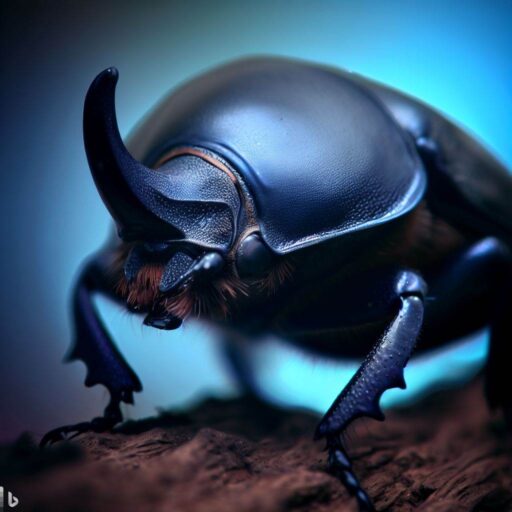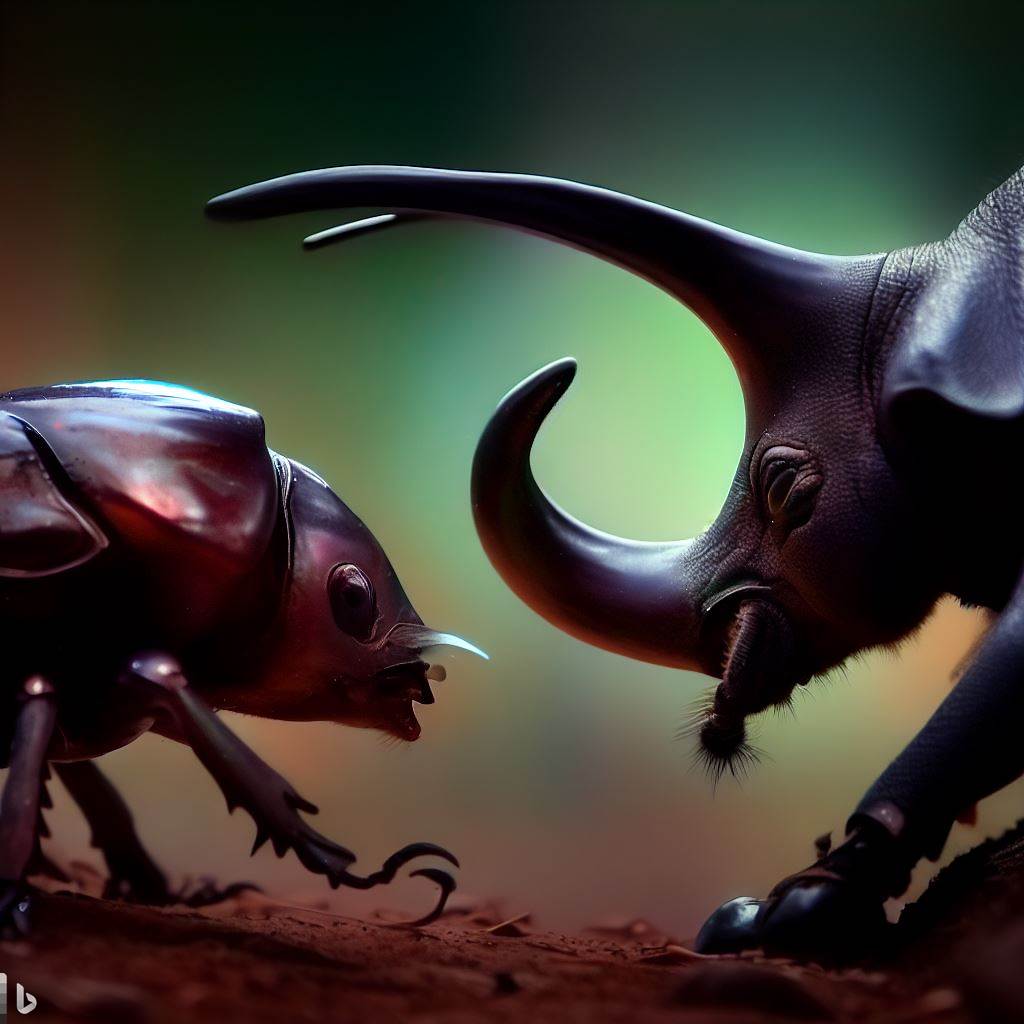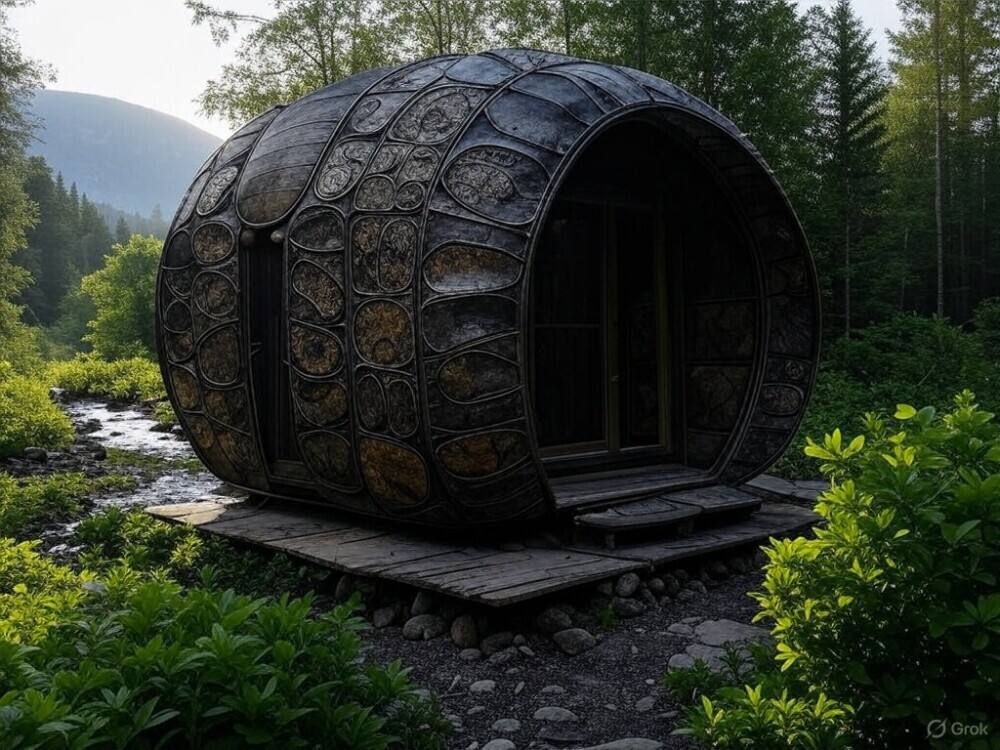Elephant Beetle vs Rhino Beetle
- Elephant beetles and rhino beetles are both fascinating creatures found in various ecosystems.
- Elephant beetles are known for their large size and distinct shape, while rhino beetles are known for their horn-like structures.
- Both species play important roles in their respective ecosystems, such as pollination and decomposition.
Elephant beetles and rhino beetles, some of the most fascinating creatures in the insect world. In this section, we will introduce you to these magnificent insects, providing insights into their unique characteristics and behaviors.
From the impressive size of the elephant beetles to the extraordinary horn-like protrusions of the rhino beetles, get ready to dive into the captivating world of these beetles and discover what sets them apart.
Introduction to Elephant Beetles
Elephant beetles, also known as Megasoma elephas, are a stunning species that belong to the Scarabaeidae family. They are widely renowned for their impressive size and strength, making them some of the biggest beetles around.
With their ivory-like color and ornate exoskeleton, they captivate entomologists and nature lovers alike.
Males can grow up to 5 inches long, and females slightly smaller at 4 inches. These beetles boast a distinct horn-like structure on their heads, which is both attractive and serves a functional purpose in battles between males during mating season.
These beetles have an essential role in the ecosystems they inhabit. As detritivores, they feed on decaying organic matter found in forests and other habitats.
This helps with nutrient cycling and decomposition, resulting in healthier soil and functioning ecosystems.
In certain societies, elephant beetles are symbols of power and strength, and are included in traditional ceremonies and rituals.
Sadly, elephant beetle populations are facing significant threats worldwide due to habitat loss, climate change, and illegal wildlife trade.
Conservation efforts such as habitat restoration, raising awareness, and legal protection measures are in place to protect these magnificent creatures.
We can learn a lot from elephant beetles. It’s important to understand their unique characteristics and importance in order to appreciate them, and take necessary steps towards their conservation.
Introduction to Rhino Beetles

Rhino Beetles are truly unique! They belong to the Scarabaeidae family, which includes Dung Beetles and June Beetles. These critters can grow up to several inches long and have a robust body structure.
Their horns are their namesake – they look like those of a rhinoceros! Male Rhino Beetles have horns for combat and defense. Females lack these horns but have other features that help them survive.
Rhino Beetles live in tropical regions around the world. Forests, grasslands, and agricultural areas are their homes. They are decomposers and pollinators, so they are important for the environment!
It is necessary to protect Rhino Beetle habitats and limit human activities that destroy their homes. Additionally, raising awareness can help promote conservation and encourage responsible environmental practices.
Elephant Beetles and Rhino Beetles are both fascinating, but Rhino Beetles are the real powerhouses!
Comparison between Elephant Beetles and Rhino Beetles
Elephant beetles and rhino beetles are two creatures of the insect world. Despite similar looks, they have unique characteristics and behaviors. Elephant beetles belong to the family Scarabaeidae.
They can grow up to six inches long. Rhino beetles, also from the same family, have horns – exclusive to males.
If you would like to see a photo of the less seen beetle, Project Noah has a great photo here.
These horned beetles reach a similar size as the elephant beetles.
Let’s compare their characteristics and behaviors.
| Elephant Beetles | Rhino Beetles | |
|---|---|---|
| Size | Up to six inches long | Up to six inches long |
| Horns | No horns | Prominent horns on males |
| Diet | Mainly decaying organic matter | Mainly decaying organic matter |
| Behavior | Mostly nocturnal | Mostly nocturnal |
Elephant and rhino beetles have different traits. Although their diet is the same, each species has its own way of adapting to its environment.
Researchers and enthusiasts explore these insects’ unique features. We can appreciate the diversity of the natural world by understanding these creatures.
Witness the extraordinary world of these beetles. Learn about their curious behaviors and distinctive traits. Observe them in their natural habitats and gain a newfound appreciation for life around us.
Explore the captivating realm of elephant and rhino beetles and be amazed by their complexity and beauty.
The Role of Elephant Beetles and Rhino Beetles in Ecosystems
Elephant beetles and rhino beetles play a big part in ecosystems. Known for their large size and unique looks, they help keep biodiversity and balance in their habitats.
Elephant beetles do a great job of breaking down dead trees and leaves. They turn them into simpler forms that can be used by the soil. This makes it easier for plants to grow.
Rhino beetles also help ecosystems by pollinating plants. They move pollen from male to female flowers, leading to fertilization and seed production. This is important for many organisms in the habitat.
These beetles are key for keeping ecosystems healthy and full of diversity. They do vital functions that keep the balance of the entire ecosystem.
Elephant beetles have strong mandibles to dig and make nests. Rhino beetles have horns to protect themselves and attract mates.
These adaptations help us understand how interconnected species are in ecosystems. When one is missing or in decline, it affects the whole balance.
It’s important to appreciate the roles of elephant beetles and rhino beetles in ecosystems. Protect and conserve these creatures and their habitats. Learn more about these amazing beetles and the ecosystems they live in.
Human Interaction and Conservation Efforts
Humans and elephant beetles, as well as rhino beetles, have a crucial relationship. Their unique characteristics and the part they play in ecology make them essential to study and protect.
These beetles are called “flagship species” – they represent the health and biodiversity of their habitats. But human activities such as deforestation, habitat destruction, and illegal trade put them in danger.
Conservation organizations, governments, and researchers work together to create strategies to save them. They help local communities with education programs, habitat restoration projects, and other livelihood options to reduce dependence on activities that hurt the beetles.
Scientific research can also provide useful knowledge about the population dynamics, breeding behaviors, and ecological needs of elephant beetles and rhino beetles. This information helps in making conservation plans, such as setting up protected areas and species-specific management practices.
Stories from field researchers show how important conservation is for these beetles. For example, a team of scientists saw a decline in elephant beetle populations due to urbanization. Thanks to the habitat corridors they created, beetle populations were recovered.
In the end, both positive and negative human interaction with elephant and rhino beetles is important for their conservation. Awareness, community involvement, scientific research, and conservation measures are all necessary to ensure their survival and maintain biodiversity.
Conclusion
The Elephant and Rhino Beetles are extraordinary species, with remarkable features. Elephant Beetles have a horn-like projection on their heads, while Rhino Beetles have one on their pronotum.
Furthermore, their diets vary according to their habitat. Elephant Beetles feed on plant material, while Rhino Beetles consume plant sap and nectar.
The adaptability of these beetles is remarkable. Elephant Beetles live in tropical rainforests, while Rhino Beetles inhabit a variety of habitats. People all over the world are captivated by these beetles, resulting in a greater understanding of them.
Therefore, studying the Elephant and Rhino Beetles provides valuable insights into the diversity and adaptation of beetles.
Some Facts About Elephant Beetles vs Rhino Beetles:
- ✅ There are over 400,000 species of beetles, with an estimated total of over a million species.
- ✅ The Dynastinae subfamily, also known as the rhinoceros beetle, is one of the largest subfamilies of beetles.
- ✅ The Hercules beetle, a species within the Dynastinae subfamily, is known for its monstrous size, with males weighing between 0.50 and 1.2 ounces.
- ✅ The Hercules beetle can reach up to 7 inches in length, including the horn, while the average rhinoceros beetle measures between 0.5 and 3 inches in length.
- ✅ Both the Hercules beetle and the rhinoceros beetle are herbivorous and consume fruit, rotting wood, tree sap, nectar, and some types of fruit.
FAQ
What are the key differences between the Elephant Beetle and Rhino Beetle?
The key differences between the Elephant Beetle and Rhino Beetle include their average size, horn-like pincers, range and habitat, and the Scarab Beetle family they belong to.
The Elephant Beetle, also known as the Hercules Beetle, is larger compared to the Rhino Beetle, weighing between 0.50 and 1.2 ounces and measuring up to 7 inches in length. It has horn-like pincers on its head, but these are only present in males.
The Rhino Beetle, on the other hand, weighs between 0.2 and 1.2 ounces and measures between 0.5 and 3 inches. Some Rhino Beetles have sizable horns used for battling other males.
Where can the Elephant Beetle and Rhino Beetle be found?
The Elephant Beetle, or Hercules Beetle, is predominantly found in Central and South America and the West Indies. It can be found in countries such as Mexico, Bolivia, Brazil, Colombia, Peru, Trinidad and Tobago, among others.
The Rhino Beetle, on the other hand, can be found on every continent except Antarctica. They have a wider range and can be found in various habitats around the world.
Are Elephant Beetles and Rhino Beetles popular as pets?
Yes, both Elephant Beetles (Hercules Beetles) and Rhino Beetles are popular as pets among insect enthusiasts. Their unique appearance, size, and behavior make them fascinating pets for many people.
However, it is essential to ensure proper care and appropriate living conditions for these beetles if they are kept as pets.
What do Elephant Beetles and Rhino Beetles eat?
Both Elephant Beetles (Hercules Beetles) and Rhino Beetles are herbivorous. They primarily consume a variety of food sources, including fruit, rotting wood, tree sap, nectar, and some types of fruit.
The larvae of these beetles have a preference for rotting wood, which serves as their main food source during the larval stage.
How many species and genera are there in the Rhino Beetle family?
The Rhino Beetle family, which includes the Elephant Beetle (Hercules Beetle), consists of approximately 1,500 species and 225 genera of rhinoceros beetles.
This diverse family showcases a wide array of different species with unique characteristics and adaptations.
Which subfamily does the Elephant Beetle belong to?
The Elephant Beetle, scientifically known as Dynastes Hercules, belongs to the Dynastinae subfamily within the Scarabaeidae family.
This subfamily is one of the largest subfamilies of beetles and is commonly referred to as the rhinoceros beetle subfamily. The Elephant Beetle is the largest extant beetle within this subfamily, known for its impressive size and horn-like pincers.





Leave a Reply